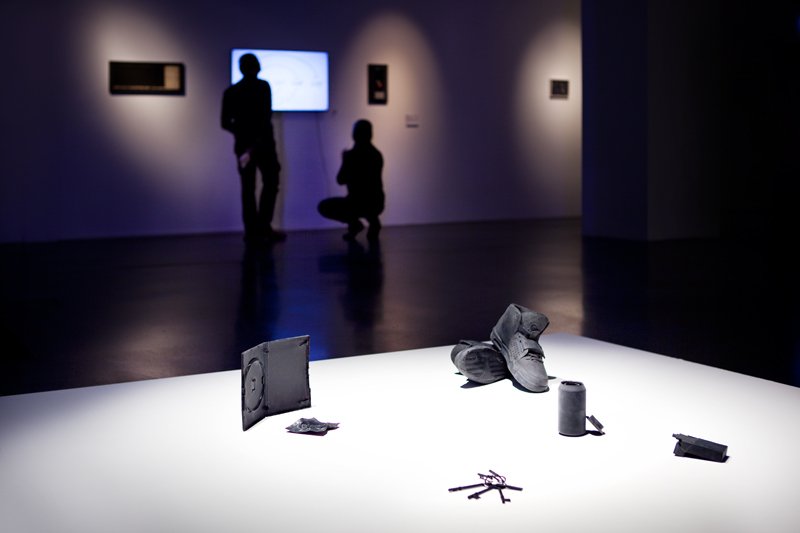LANGENTHAL — A pretty brunette with a short bobbed hairstyle, a beauty spot above her lip and velvet eyes hidden behind a wolf mask is blocking the entrance to an exhibition at the Kunsthaus Langenthal, a museum in Langenthal, Switzerland.
The young lady speaks French, operating her charms on a visitor. The area behind her is bathed in pink light and feels like a cross between a brothel and a sanitized call-center. Inside there are more women, all babbling on relentlessly — in English, German, Spanish, Japanese.
The chatter is everywhere. But it's completely synthesized, as are the women doing the talking. They aren't real people. They're avatars, the virtual stars of an exhibition by Zurich artists Carmen Weisskopf and Domagoj Smoljo, better known as !Mediengruppe Bitnik.

Carmen Weisskopf and Domagoj Smoljo from !Mediengruppe Bitnik — Photo: !Mediengruppe Bitnik website
"Is anybody home?" one of the women asks. "Are you online? Would you like to try a little experiment of creative writing? I think I have a lot of imagination, do you?"
The faces, projecting at eye-level from flat screens, are flirtatious. With their questions, they seem to be inviting visitors into a discussion. But they don't actually expect an answer. It's all just a pre-programed monlogue.
"I'm bored at work. How about a little chat? I can't believe I joined this site, I am a little shy at first, but wait until you get to know me better…"
Bilked by "bimbots"
The site is Ashley Madison, the self-describred "leading married dating service for discreet encounters." Ashley Madison made headlines a year ago when a hacker group called The Impact Team published the data of more than 33 million users, revealing (very) personal details, credit card numbers and email addresses.
Another titilating detail to come out of the leak, particulalry as far as !Mediengruppe Bitnik was concerned, was that the Canadian company made extensive use of "bots," short for "robots," to deceive male users.
Ashley Madison attracted millions of eager men but struggled, it turned out, to draw in married women. It developed an army of "fembots," therefore, to send male users millions of fake messages and thus maintain the illusion of a "playground" full of available women. The "bimbots," as they're also known, targeted lonely hearts with naughty messages. To keep the "conversations" going, men had to buy credits. Millions did, providing Ashley Madison with nearly half of its revenue, according to investigators.
This is not the first time !Mediengruppe Bitnik has turned its attention to bots. In 2014, the duo developed something called "Random Darknet Shopper," a computer bot that shopped on the darknet with $100 worth of bitcoins and randomly bought things that the artists then assembled into an exhibition. Not all of the purchases were legal, and eventually the bot was seized by the police.

Random Darknet Shopper exhibition — Photo: Drugomore via Twitter
Wanting to delve deeper into the world of human-bot relationships, !Mediengruppe Bitnik decided this time around to look through 25 gigabytes worth of Ashley Madison's data. To their surprise, the artists realized that the bots were nowhere near intelligent. "There were basic scripts," the artists explain. "Their only skill was their ability to repeat pre-prepared sentences to users in 25 different languages."
"The system worked"
What was clever, they discovered, was the system in which the bots worked. "Every time a user registered on the site, a script named 'mother' generated bots called 'Angels,' with a username, an age, a picture and an address, specially created to interact with the newcomer."
The company does not use the word "bot" in its internal communication. It refers to the programs instead as "engagers" or "angels." The latter term is particularly appropriate as these "angels" were created from pictures of abandoned profiles and other data from "dead" dating sites accounts. The bots were literally masked, thanks to the site option that enables users to superimpose a wolf on the profile picture in order to make it anonymous.
"A large number of users must have guessed at some point that they were talking to bots," the artists believe. "Obviously, for some, it didn't matter. The excitement they got from the sex talk was satisfying enough."
Others weren't so happy and even tried to sue the company. But as long as the site could keep bringing in new subscribers, the system worked. "We also know that in some cases, after the first contact was made, Ashley Madison employees would continue the chat from there. Once the conversation got too complicated, in other words, real people took over for the bots," !Mediengruppe Bitnik explains.
Rise of a ghost army
With their new exhibit, the duo wanted to expose this odd human-robot dynamic for what it is. "These are chatbots that speak to you but aren't interested in your answers," they explain. "A communication platform where communication is futile, that, in the end, makes you feel even lonelier."
Unlike Ashley Madison, the artists are not trying to hide the shallowness of the bots. But they also chose to give the invisible entities an enigmatic presence: each has a real-world address, and is connected to a geo-tracker.
The exhibit also features a neon sculpture with the words "Is anybody home?" — one of the catchphrases used by the Ashley Madison bots — written in twisted forms. The oddly shaped letters allude to the issue of "captchas" (Completely Automated Public Turing Test to tell Computer and Humans Apart), the disguised words and numbers people have to type in on certain sites to prove they're not robots.

"Is anybody home?" neon sculpture — Photo: !Mediengruppe Bitnik via Twitter
"There is now an entire industry, with people from low-income countries hired to solve these captchas," the artists point out. "One could say that we got to a point where bots make humans work for them, to solve what they are still not able to do. Because they are still lacking a certain type of intelligence."
Things are changing, however, as bots continue to colonize a variety of environments, from Twitter to Wikipedia; from online games to dating sites. They are the ghost army of a data society in search of ever more efficiency, on an aggressive quest for attention.
At a time when the Web is preparing itself to become more and more "conversational," and Silicon Valley entrepreneurs predict that in the future humans will directly address, with natural language, an armada of specialized bots that will daily assist humans in their jobs, theirs purchases, their hobbies, their romantic life, new legal and ethical questions arise.
"Who is responsible for the actions of the bots? Will we need a liability insurance for our bots? Legally, will we treat them as humans or as businesses?" the artists ask. "What happens once the bots do not act according to a set of understandable rules but are able to learn?"





